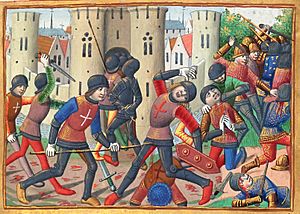Siege of Montargis facts for kids
Quick facts for kids Siege of Montargis |
|||||||
|---|---|---|---|---|---|---|---|
| Part of the Hundred Years' War | |||||||
 The Siege of Montargis, illustration of the manuscript of Martial d'Auvergne, Les Vigiles de Charles VII, Paris, BnF, circa 1484. |
|||||||
|
|||||||
| Belligerents | |||||||
| Commanders and leaders | |||||||
| Jean de Dunois La Hire |
Earl of Warwick | ||||||
| Strength | |||||||
| Garrison Relief army: 1,600 |
3,000 men Artillery |
||||||
| Casualties and losses | |||||||
| 1,000 men Artillery and baggage |
|||||||
The Siege of Montargis was an important battle during the Hundred Years' War. It happened from July 15 to September 5, 1427. In this battle, a French army led by Jean de Dunois defeated an English army. The English forces were commanded by the Earl of Warwick. This victory was a big moment for France.
Contents
Setting the Scene: Before the Battle
In June 1427, John of Lancaster, who was the Duke of Bedford, gave an order. He told Richard Beauchamp, the Earl of Warwick, to capture a French fort. This fort was called Montargis.
Montargis: A Stronghold
Montargis was a very strong place. It was built on high ground between two rivers, the Loing and the Vernisson. Many canals also ran through the town. The fort had a good number of soldiers and plenty of supplies.
English Attack Begins
The Earl of Warwick led about 3,000 English soldiers. They also had powerful cannons. On July 15, 1427, they started their attack. They surrounded Montargis and began the siege.
The Siege: A Tough Fight
The English army kept firing their cannons at Montargis. But even with all the bombardments, they didn't make much progress. The French defenders inside the fort held strong.
French Help Arrives
By early September, the French leader, Dauphin Charles, sent help. He sent a group of 1,600 soldiers. This relief army was led by two brave commanders: Jean de Dunois and La Hire.
A Clever Plan
Dunois let the soldiers inside Montargis know that he had arrived. Together, they made a smart plan to defeat the English. Dunois's army showed up south of the town. The English tried to attack them by crossing a wooden bridge.
The Turning Point
As the English soldiers were crossing the bridge, the defenders inside Montargis acted fast. They opened the town's sluice gates. This released a lot of water, which swept away the bridge! This action split the English army into two parts.
French Victory
With the English army divided, the French attacked from both sides. The soldiers from inside Montargis attacked, and Dunois's relief army attacked. The Earl of Warwick's army lost about one-third of its soldiers. They also lost all their cannons and supplies as they ran away.
After the Battle: French Morale Soars
The victory at Montargis was a huge boost for the French. It made their soldiers feel much more hopeful. It also made Jean de Dunois even more famous as a military leader. This battle showed that the French could win important fights during the Hundred Years' War.

